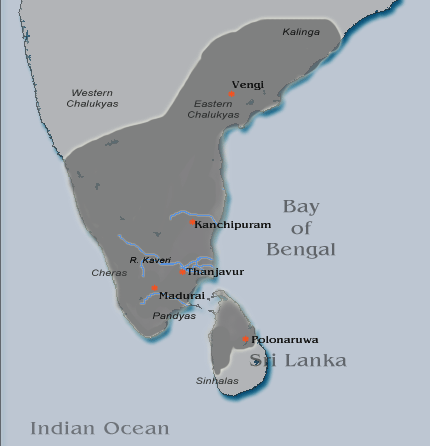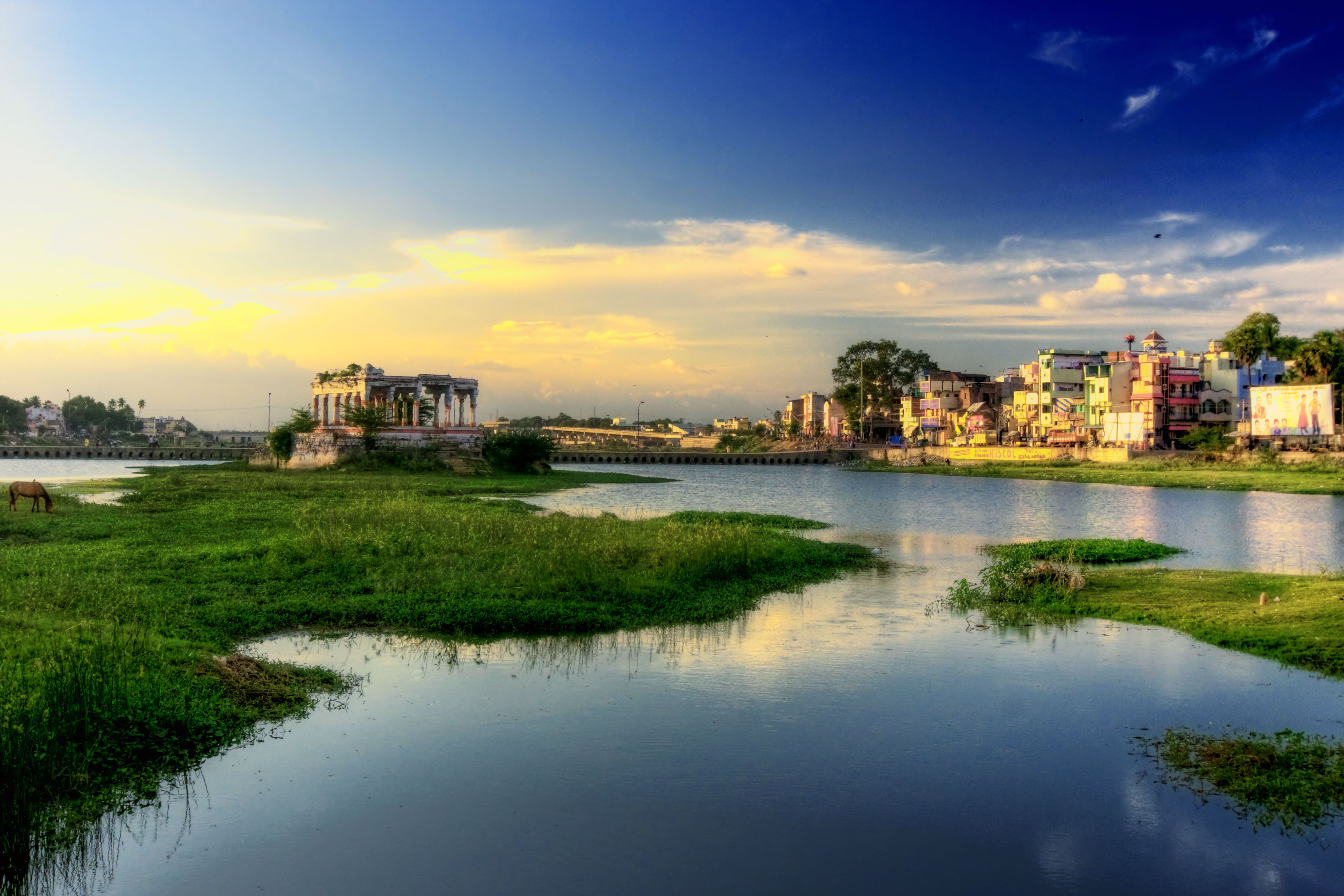|
Aditya Chola II
Aditya II (942 CE - 971 CE), commonly known as Aditya Karikalan was a Chola prince who lived in the 10th century in India. He was born in Tirukoilur and was the eldest son of Parantaka Chola II. He was the elder brother of Rajaraja Chola I and Kundavai. He was called as ''Virapandiyan Thalai Konda Koparakesari Varman Karikalan''. He led the Chola expedition against the Pandyas and defeated the Pandya king Veerapandyan at the Battle of Chevur. He killed Veerapandiyan after chasing him on the banks of Vaigai river. Aditya was made the co-regent and heir apparent to the Chola throne even though Uttama Chola, the son of Gandaradita Chola, had more right to the throne. He was assassinated by the associates of Veerapandiyan in revenge for the defeat. Aditya was succeeded by Uttama Chola. As per epigraphs, the inquiry into the death was completed in the second year of Rajaraja Chola I's reign and the lands of certain officials were confiscated for their complicity in the murder of ... [...More Info...] [...Related Items...] OR: [Wikipedia] [Google] [Baidu] |
Brihadisvara Temple
Brihadishvara Temple, called Rajarajesvaram () by its builder, and known locally as ''Thanjai Periya Kovil'' ("Thanjavur Big Temple") and ''Peruvudaiyar Kovil'', is a Shaivite Hindu temple built in a Chola architectural style located on the south bank of the Cauvery river in Thanjavur, Tamil Nadu, India.Thanjavur Encyclopaedia Britannica It is one of the largest Hindu temples and an exemplar of . It is also called ''Dakshina Meru'' (" |
Parantaka Chola II
Parantaka Chola II (Tamil: இரண்டாம் பராந்தக சோழன்) (r. 958 – 973 CE) was a Chola emperor. He is also known as Sundara Chola as he was considered an epitome of male beauty.''Early Chola temples:Parantaka I to Rajaraja I, A.D. 907-985''''Journal of Indian museums, Volumes 14-16, page 35''''A Topographical List of Inscriptions in the Tamil Nadu and Kerala States: Nilgiris District, Pudukkottai District, Ramanathapuram District, Salem District, page 41'' He was the son of Arinjaya Chola and queen Kalyani, a princess of Vaidumba family. Parantaka II ascended the Chola throne despite the fact that his cousin Madurantaka Uttama Chola, the son of Gandaraditya Chola(the elder brother of Arinjaya Chola) was alive and he had equal if not more claim to the Chola throne. When Parantaka II became king, the Chola kingdom had shrunk to the size of a small principality. The Pandyas in the south had revived their fortunes and had defeated the Chola ar ... [...More Info...] [...Related Items...] OR: [Wikipedia] [Google] [Baidu] |
942 Births
94 may refer to: * 94 (number) * one of the years 94 BC, AD 94, 1994, 2094, etc. * Atomic number 94: plutonium * Saab 94 The Saab Sonett is an automobile manufactured between 1955 and 1957 and again between 1966 and 1974 by Saab of Sweden. Sonetts share engines and other components with Saab 93, 95 and 96 of the same era. It was mainly intended for the lucrativ ... See also * * List of highways numbered {{Numberdis ... [...More Info...] [...Related Items...] OR: [Wikipedia] [Google] [Baidu] |
10th-century Indian Monarchs
1 (one, unit, unity) is a number representing a single or the only entity. 1 is also a numerical digit and represents a single unit of counting or measurement. For example, a line segment of ''unit length'' is a line segment of length 1. In conventions of sign where zero is considered neither positive nor negative, 1 is the first and smallest positive integer. It is also sometimes considered the first of the infinite sequence of natural numbers, followed by 2, although by other definitions 1 is the second natural number, following 0. The fundamental mathematical property of 1 is to be a multiplicative identity, meaning that any number multiplied by 1 equals the same number. Most if not all properties of 1 can be deduced from this. In advanced mathematics, a multiplicative identity is often denoted 1, even if it is not a number. 1 is by convention not considered a prime number; this was not universally accepted until the mid-20th century. Additionally, 1 is the s ... [...More Info...] [...Related Items...] OR: [Wikipedia] [Google] [Baidu] |
Chola Dynasty
The Chola dynasty was a Tamils, Tamil thalassocratic Tamil Dynasties, empire of southern India and one of the longest-ruling dynasties in the history of the world. The earliest datable references to the Chola are from inscriptions dated to the 3rd century BCE during the reign of Ashoka of the Maurya Empire. As one of the Three Crowned Kings of Tamilakam, along with the Chera dynasty, Chera and Pandya dynasty, Pandya, the dynasty continued to govern over varying territories until the 13th century CE. The Chola Empire was at its peak under the Medieval Cholas in the mid-9th century CE. The heartland of the Cholas was the fertile valley of the Kaveri River. They ruled a significantly larger area at the height of their power from the later half of the 9th century till the beginning of the 13th century. They unified peninsular India south of the Tungabhadra River, and held the territory as one state for three centuries between 907 and 1215 CE.K. A. Nilakanta Sastri, ''A Histo ... [...More Info...] [...Related Items...] OR: [Wikipedia] [Google] [Baidu] |
Rajaraja I
Rajaraja I (947 CE – 1014 CE), born Arunmozhi Varman or Arulmozhi Varman and often described as Raja Raja the Great or Raja Raja Chozhan was a Chola emperor who reigned from 985 CE to 1014 CE. He was the most powerful Tamil king in South India during his reign and is remembered for reinstating the Chola influence and ensuring its supremacy across the Indian Ocean. His extensive empire included vast regions of the Pandya country, the Chera country and northern Sri Lanka. He also acquired Lakshadweep and Thiladhunmadulu atoll, and part of the northern-most islands of the Maldives in the Indian Ocean. Campaigns against the Western Gangas and the Chalukyas extended the Chola authority as far as the Tungabhadra River. On the eastern coast, he battled with the Chalukyas for the possession of Vengi.A Journey through India's Past by Chandra Mauli Mani p.51 Rajaraja I, being an able administrator, also built the great Rajarajeshwaram Temple at the Chola capital Thanjavur. The ... [...More Info...] [...Related Items...] OR: [Wikipedia] [Google] [Baidu] |
Kudavayil Balasubramanian
Kudavayil Balasubramanian (born Kudavayil, Tiruvarur district) is an archaeologist from Tamil Nadu, India. He is former curator and publication manager at Saraswathi Mahal Library located at Thanjavur. He is credited with discovering more than 100 inscriptions, coins, copper plates, sculptures, and paintings now in museums and temples in that state. Balasubramanian received a bachelor's in zoology, and studied history as a post-graduate. For his contribution to temple art and Tamil language he received (Doctor of Letters (honoris causa)) in February 2016. Twenty seven books all magnum opuses, twenty booklets, fifty three seminar papers and four hundred and fifty articles have been brought out in the fields of History, Archaeology, Numismatics, Epigraphy, Temple Architecture, Saiva Agamas, Sculptures, Paintings, Music and Dance by Dr. Kudavayil Balasubramanian. His discovery of Nandipuram near Kandiyur and its shrine housing 1000 Siva Lingas, is hailed as the greatest of his ac ... [...More Info...] [...Related Items...] OR: [Wikipedia] [Google] [Baidu] |
Archaeology
Archaeology or archeology is the scientific study of human activity through the recovery and analysis of material culture. The archaeological record consists of artifacts, architecture, biofacts or ecofacts, sites, and cultural landscapes. Archaeology can be considered both a social science and a branch of the humanities. It is usually considered an independent academic discipline, but may also be classified as part of anthropology (in North America – the four-field approach), history or geography. Archaeologists study human prehistory and history, from the development of the first stone tools at Lomekwi in East Africa 3.3 million years ago up until recent decades. Archaeology is distinct from palaeontology, which is the study of fossil remains. Archaeology is particularly important for learning about prehistoric societies, for which, by definition, there are no written records. Prehistory includes over 99% of the human past, from the Paleolithic until the adven ... [...More Info...] [...Related Items...] OR: [Wikipedia] [Google] [Baidu] |
Vaigai River
The Vaigai is a river in the Tamil Nadu state of southern India; it passes through the towns of Theni, Dindigul and Madurai. It originates in Varusanadu Hills, the Periyar Plateau of the Western Ghats range, and flows northeast through the Kambam Valley, which lies between the Palani Hills to the north and the Varushanad Hills to the south. The Vattaparai Falls are located on this river. As it rounds the eastern corner of the Varushanad Hills, the river turns southeast, running through the region of Pandya Nadu. Madurai, the largest city in the Pandya Nadu region and its ancient capital, lies on the Vaigai. The river empties into the Palk Bay near Alagankulam, close to Pamban Bridge in Ramanathapuram District. The Vaigai is long, with a drainage basin large. Vaigai Mention Sangam literature (circa 300 BCE to 300 CE) has paid many tributes to Vaigai, extolling it as 'the river that brings water when one touches it', viz the etymology Vai (place your) + gai (hands) = plac ... [...More Info...] [...Related Items...] OR: [Wikipedia] [Google] [Baidu] |
Kundavai Pirāttiyār
Kundavai Pirattiyar commonly known mononymously as Kundavai, was a princess of the Chola empire who lived in the tenth century in South India.''Lalit kalā, Issue 15, page 34'' She was the daughter of Parantaka II and Vanavan Mahadevi.''Early Chola art, page 183''''A Topographical List of Inscriptions in the Tamil Nadu and Kerala States: Thanjavur District, page 180''''Worshiping Śiva in medieval India: ritual in an oscillating universe, page 5'' She was born in Tirukoilur and was the elder sister of Chola emperor Rajaraja I. She had title as ''Ilaiyapirātti Kundavai Nachiyar''. However when her husband Vallavaraiyan Vandiyadevan was crowned king in his hometown Bana Kingdom, she did not accept the offer to become queen of the kingdom and remained as the princess of Tanjore. Life Kundavai (also transliterated as Kundhavai or Kunthavai) was born in 945 CE. She was the only daughter of the Chola king Parantaka II and queen Vanavan Mahadevi. She had an elder brother – Adith ... [...More Info...] [...Related Items...] OR: [Wikipedia] [Google] [Baidu] |
Rajaraja Chola I
Rajaraja I (947 CE – 1014 CE), born Arunmozhi Varman or Arulmozhi Varman and often described as Raja Raja the Great or Raja Raja Chozhan was a Chola emperor who reigned from 985 CE to 1014 CE. He was the most powerful Tamil king in South India during his reign and is remembered for reinstating the Chola influence and ensuring its supremacy across the Indian Ocean. His extensive empire included vast regions of the Pandya country, the Chera country and northern Sri Lanka. He also acquired Lakshadweep and Thiladhunmadulu atoll, and part of the northern-most islands of the Maldives in the Indian Ocean. Campaigns against the Western Gangas and the Chalukyas extended the Chola authority as far as the Tungabhadra River. On the eastern coast, he battled with the Chalukyas for the possession of Vengi.A Journey through India's Past by Chandra Mauli Mani p.51 Rajaraja I, being an able administrator, also built the great Rajarajeshwaram Temple at the Chola capital Thanjavur. The ... [...More Info...] [...Related Items...] OR: [Wikipedia] [Google] [Baidu] |





.jpg)


